Performance and yield stability of maize hybrids in stress-prone environments in eastern Africa
Wnr Sntos Rzn, Yosph Byn*, Stphn Mugo Eri Nou,Mnj GowJulius Pyton Ssrumg, Gory As, Ismil Ngolin,MDonl JumoSylvstr O.Oikh, Mihl Olsn Aluízio Borém,Cosm Dmi?o Cruz,Bouplli M. Prsnn
aFederal University of Vi?osa(UFV),P. O.Box 36570000,Vi?osa,Brazil
bInternational Maize and Wheat Improvement Center(CIMMYT), P.O.Box 1041-00621,Nairobi,Kenya
cBayer Crop Science,P. O.Box 1512,Petit,South Africa
dNational Crops Resources Research Institute(NaCRRI), P.O.Box 7084,Kampala,Uganda
eIlonga Agricultural Research Institute(ARI-Ilonga), P.O.Box 66,Kilosa,Tanzania
fAfrican Agricultural Technology Foundation(AATF),P.O.Box 30709-00100, Nairobi, Kenya
Keywords:Drought stress Eastern Africa Genotype by environment interaction Yield stability Zea mays L.
ABSTRACT Identification and deployment of high-yielding and stress-tolerant maize hybrids adapted to stress-prone agro-ecologies is important for improving the food security and livelihoods of smallholder farmers in eastern Africa. The objectives of this study were to (i) assess the performance of maize hybrids under well-watered and drought stress conditions; (ii)evaluate grain yield stability of 65 intermediate-maturing and 55 early-maturing hybrids in 24 well-watered locations and seven drought stress locations; and (iii) identify representative and/or discriminative testing locations for increasing genetic gains for the target traits. There were significant differences for grain yield among early- and intermediatematuring hybrids tested under well-watered and drought stress environments. Among the early-maturing hybrids, the top 10 hybrids produced 46.8%-73.9% and 31.2%-42.1% higher mean grain yields than the best commercial check under drought and well-watered conditions, respectively. Among the intermediate-maturing hybrids, the top 10 hybrids produced 25.2%-47.7% and 8.5%-13.5% higher grain yield than commercial checks under drought stress and well-watered conditions, respectively, suggesting improvement in the levels of drought tolerance in both early- and intermediate-maturing hybrids. GGE biplot analysis and a bi-segmented regression linear method identified specific early-maturing and intermediate-maturing hybrids that performed well under both well-watered and drought stress conditions. These hybrids could be recommended for commercial production in eastern Africa. Kakamega in Kenya was found to be the most representative and highly discriminating site among well-watered testing locations, while Kabuku in Tanzania was the least representative of test locations. For testing under drought stress conditions, Kiboko in Kenya was identified as the most representative location. This information could be useful for allocating resources and streamlining CIMMYT maize hybrid testing in eastern Africa.
1. Introduction
Maize is the main staple food in eastern Africa, accounting for nearly 50%of total calorie intake in the region[1]and an annual production of 28 million metric tons on 25% of the agricultural area [2]. Both production and productivity of maize need to be increased in this region, owing to rapid population and economic growth [3]. Between 2017 and 2050, the African population is projected to grow by 90%,from the current 1.3 billion to 2.5 billion [4]. The average maize yield in sub-Saharan Africa (SSA) is 1.8 t ha-1, which is lower than in other maize-growing regions in the developing world and below the world average of 4.9 t ha-1.This low productivity is attributed to several factors,including drought, poor soil fertility, insect pests, and diseases.
Drought stress, which causes several changes in morphophysiological traits and metabolism of plants, is a major constraint to maize production in eastern Africa [5-7]. About 40% of the maize-growing areas in Africa experience occasional drought stress,resulting in yield losses of 10%-25%[8].Drought stress is also predicted to occur more frequently and severely in future owing to the changing climate[3],impairing agricultural production especially in the tropics and subtropics and particularly in SSA [9,10]. Crop production in SSA is mainly by smallholder farmers who are highly dependent on rainfall for sustaining the crops. Thus, development and deployment of tropical maize varieties with drought tolerance and other relevant agronomic and adaptive traits is key to enhancing the food security and livelihoods of maize farming communities in regions such as eastern Africa.
Breeding for drought tolerance and yield stability is an important objective of maize breeding programs in SSA and a high priority for the CIMMYT Global Maize Program [11].Inbred lines with superior breeding values for grain yield and tolerance to abiotic stresses are used as base materials for developing high-yielding and drought-tolerant hybrids [11].Under the Water Efficient Maize for Africa(WEMA)[12,13],and Stress Tolerant Maize for Africa(STMA)projects,CIMMYT has adopted several breeding approaches for developing droughtstress tolerant maize hybrids adapted to SSA. These include pedigree selection, marker-assisted recurrent selection(MARS),and genomic selection(GS)[6].Over the past decades,CIMMYT has made progress in developing maize germplasm tolerant to drought and low nitrogen[11,14].Wossen et al.[15]reported that if farmers had not adopted these droughttolerant (DT) maize cultivars, their yields would have decreased by 13.3%,poverty would have increased by 12.9%,and the probability of seasonal food scarcity would have increased by 84.0%. Yet the seed cost and labor required to grow DT maize cultivars are no different from those for non-DT cultivars[8].
In the process of breeding, newly developed hybrids should be tested in multiple relevant locations for several years to determine their performance and adaptability before commercial release. Genotype-by-environment (GE)interaction may cause inconsistencies in genotype ranking across environments, making the selection of suitable maize hybrids challenging [16,17]. Thus, identifying and interpreting GE interaction is essential for genetic progress [18]. To reduce the negative effects of GE interaction it is important to identify stable genotypes across multiple environments and to characterize the ability of test environments to discriminate genotypes and to represent the target population of environments in each region[19,20].
Several statistical methods are available to analyze GE interaction and genotype stability, including those based on linear regression[21,22],bi-segmented regression[23,24],nonparametric tests [25,26] and linear-bilinear models such as AMMI and GGE biplot [27,28]. Some of these methods are considered as alternatives and others as complementary,and use of more than one method to study GE interaction could increase efficiency[29,30].
The objectives of this study were (i) to evaluate the performance of maize hybrids under well-watered and drought stress conditions in eastern Africa, (ii) to estimate the grain yield stability of 65 intermediate-maturing and 55 early-maturing hybrids across seven drought stress locations and 24 optimum (well-watered) locations, and (iii) to identify the best representative and/or discriminating testing locations for increasing genetic gains for the target traits.
2. Materials and methods
2.1.Germplasm,experimental sites,experimental design,and field evaluations
A total of 55 early-maturing and 65 intermediate-maturing maize hybrids (at stage 4 of testing) were selected for regional trials in this study.CIMMYT regional trials are the last stage of testing in the breeding cycle, and include promising pre-commercial DT maize hybrids along with relevant commercial checks, and the evaluation data are used for the annual hybrid advancement process. The hybrids in these trials were selected based on yield and other agronomic traits from the first, second, and third stages of testing across locations within CIMMYT maize breeding pipelines (Beyene et al., unpublished data). Five commercial checks were included in trials with earlymaturing hybrids and seven commercial checks in trials with intermediate-maturing hybrids. The experimentalhybrids and commercial checks were evaluated in 23-24 well-watered (WW) and 6-7 drought stress (DS) locations,depending on maturity,in Kenya,Uganda,and Tanzania in 2017 (Table 1). The experimental design was an alpha lattice with two replications.Trials with a mean grain yield of <3 t ha-1were treated as DS trials, while those with mean grain yield of >3 t ha-1were considered WW trials[31]. Entries were planted in two-row plots, 5 m long, with 0.75 m spacing between rows and 0.25 m between hills.Two seeds per hill were initially planted and then thinned to one plant per hill at three weeks after emergence for a final plant population density of 53,333 plants ha-1. Fertilizers were applied at the rate of 60 kg N and 60 kg P2O5-ha-1as recommended for the area. Nitrogen was applied twice: at planting and 6 weeks after emergence. Fields were kept free of weeds by hand weeding.
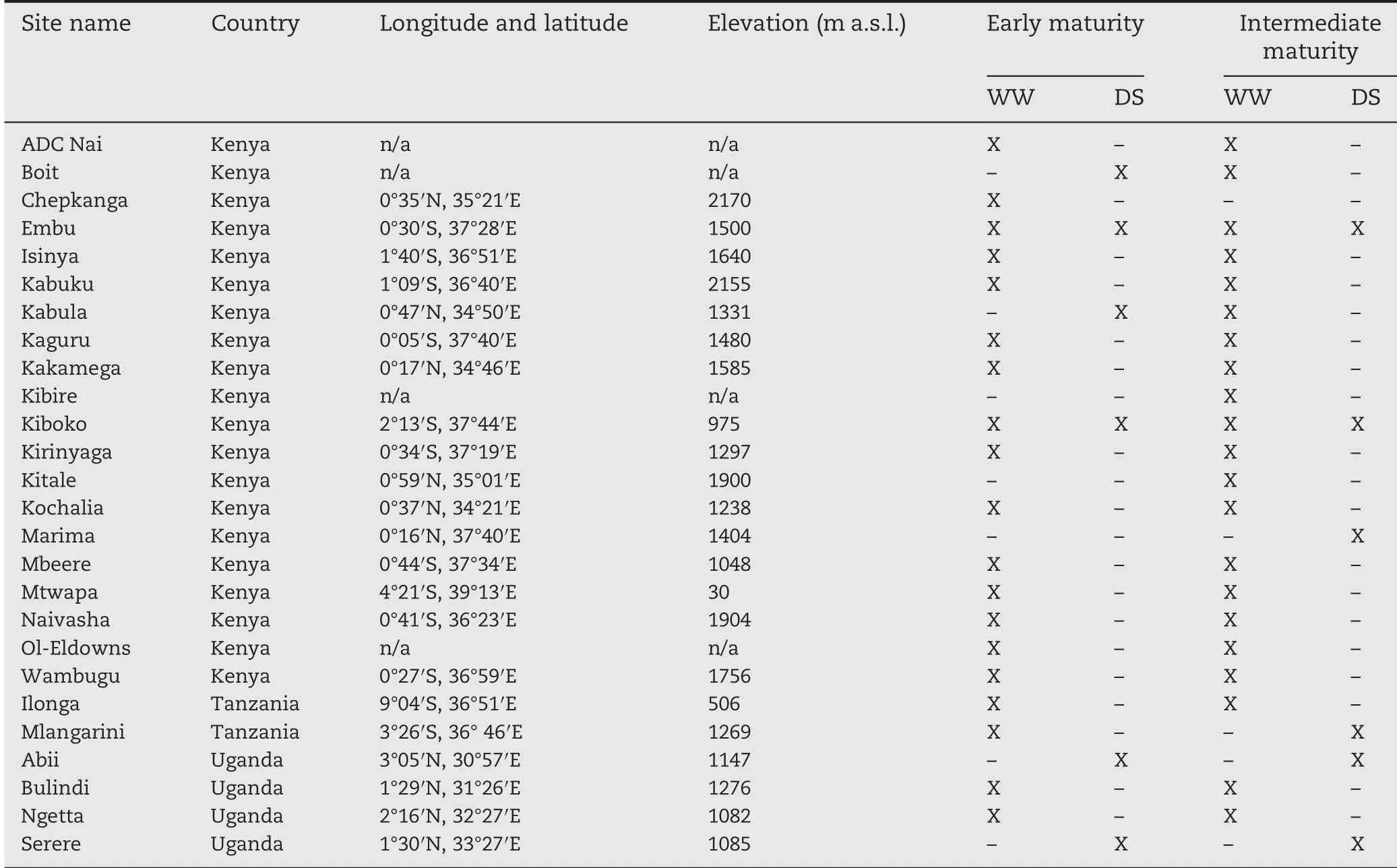
Table 1-Description of experimental sites used to evaluate maize hybrids in eastern Africa.
Grain yield(GY),anthesis date(AD),plant height(PH),gray leaf spot(GLS,caused by Cercospora zeae-maydis)and northern corn leaf blight or Turcicum leaf blight (NCLB/TLB, caused by Exserohilum turcicum) were recorded. PH was measured in cm as the distance from the base of the plant to the height of the first tassel branch.AD was determined as the number of days from sowing until 50% of plants shed pollen. GLS and NCLB were measured on a 1-5 scale, where 1 was highly resistant(with no symptoms) and 5 was highly susceptible. GY was calculated from ear weight based on an average shelling percentage of 80%, adjusted to 12.5% moisture content, and converted to t ha-1.
2.2. Data analysis
Best linear unbiased estimates (BLUEs) for grain yield across locations for each trial and each trait were generated using the following linear mixed model[32]:

where Yijrkis the grain yield of genotype i at location j in replicate r within block k; μ is the general mean; Ljis the fixed effect of location j; Rr(Lj) is the fixed effect of replicate r within location j; Bk[Rr(Lj)] is the random effect of incomplete block k within replicate r and location j,assumed to be independently and identically normally distributed with mean zero and variance; Giis the fixed effect of genotype i; GLijis the fixed effect of genotype × location interaction; and εijrkis the random residual error,assumed independently and identically normally distributed with mean zero and variance.
Variance components and heritability across locations were estimated.Broad-sense heritability(H2)was estimated based on entry means as follows:
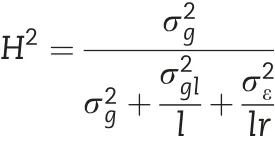
The BLUEs for each location were generated and used for GGE biplot analyses with META-R software[33].
The GY stability of the hybrids and the suitability of the test environments for selecting these hybrids were assessed using the multivariate method GGE biplot based on the following model[28]:

where Yijis the mean grain yield of genotype i in environment j;Yjis the mean grain yield of environment j;λ1and λ2are the singular values of the first and second principal components,PC1 and PC2,respectively;ξi1and ξi2are the scores of genotype i for PC1 and PC2, respectively; η1jand η2jare the scores of environment j for PC1 and PC2,respectively;and εijis the error associated with the model[28].
GGE biplot analyses were performed for each management regime (Early WW, Early DS, Intermediate WW, and Intermediate DS)and hybrid maturity(all early-maturing trials and all intermediate-maturing trials) separately. These analyses were performed with the GGE Biplots [34] and ggplot2 [35]packages of R 3.4.3[36].
The GY stability of the hybrids was assessed following Cruz et al. [24]. These analyses were performed for only the trials grouped by hybrid maturity and using means instead of BLUEs. Cruz et al. [24] presented a bi-segmented regression linear method based on the following model:

where Yijis the average grain yield of genotype i in location j;Ijis the environmental index;T(Ij)=0 if Ij<0,T(Ij)=Ij- I+if Ij>0,where I+is the mean of the positive Ijindexes;β0iis the general mean of genotype i; β1iis the coefficient of the linear regression associated with Ij; β2iis the coefficient of linear regression associated with T(Ij); σijis the deviation of the linear regression; and εijis the experimental error. These analyses were performed using Genes software[37].
3. Results
The combined analysis of variance across WW and DS environments showed highly significant differences among genotypes for GY, PH, AD, GLS, and NCLB. The proportion of genotype to GE variance was higher for WW than for DS,indicating that GE interaction was greater under drought stress than under optimum-moisture conditions. Genotypic variance for GY for early- and intermediate-maturing hybrid trials was 137%-150% higher under WW than under DS conditions. Broad-sense heritability estimates for GY were slightly higher under WW(0.92 for both maturity groups)than under DS(0.73-0.75)conditions(Table 2).
3.1. Hybrid performance
In the early-maturing hybrids evaluated across 23 WW locations (hereafter referred to as Early WW), GY ranged from 4.13 (E53, commercial check) to 7.01 t ha-1(E11, experimental hybrid).In the Early WW,the top 10 hybrids produced a mean grain yield of 6.67 t ha-1, representing an addition of 2.04 t ha-1compared to the mean of commercial checks, and 1.74 t ha-1compared to the best commercial check (E55 with 4.93 t ha-1). The top 10 hybrids on average showed 10 cm increase in PH compared to the mean of the commercial checks. However,there was no difference between the top 10 hybrids and the commercial checks in AD and in their responses to the two main foliar diseases, GLS and NCLB(Table 3).
In combined analyses across seven drought stress locations(hereafter referred to as Early DS),mean GY ranged from as low as 1.75 (E51, commercial check) to as high as 4.31 t ha-1(E14,experimental hybrid).Among early-maturing hybrids,the top 10 hybrids produced 46.8%-73.9% higher mean GY than the best commercial check under drought stress. In Early DS, the meangrain yield of the top 10 hybrids was 3.84 t ha-1,representing an increase of 1.42 t ha-1over the mean of checks(increase of 59%)and 1.32 t ha-1(52.4%)over the best check(E52).The hybrids did not show significant differences in other traits(Table 3).
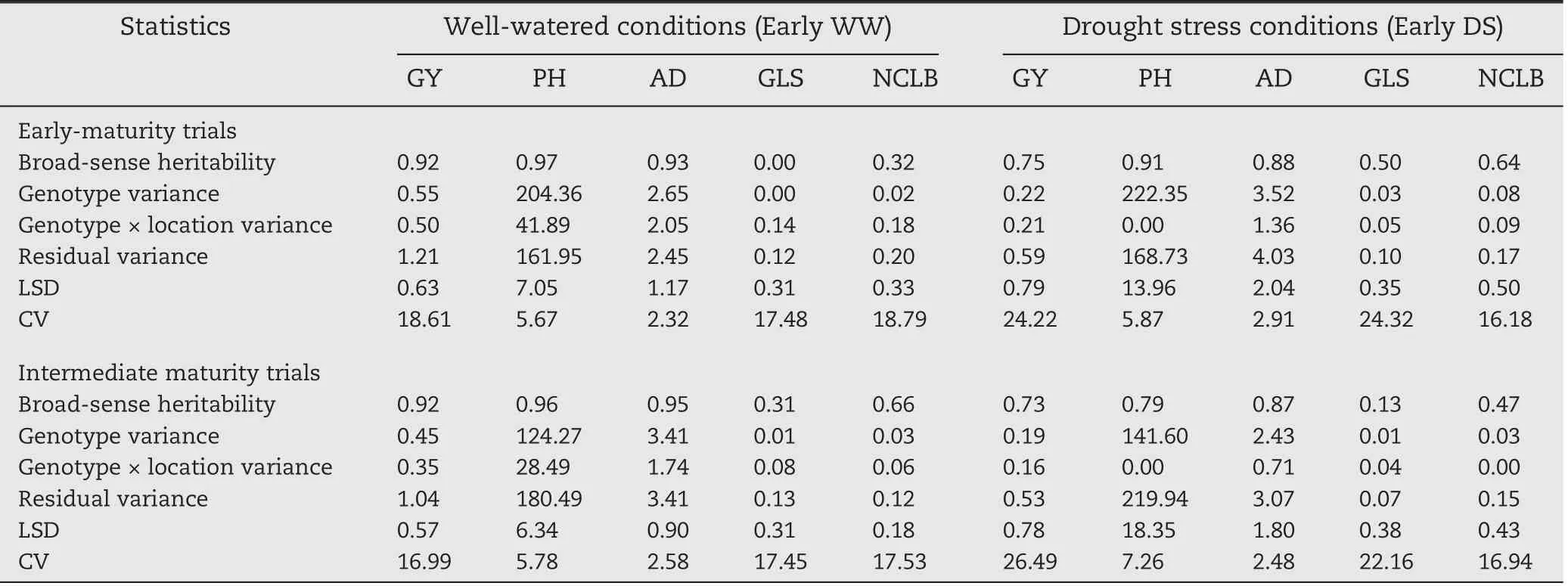
Table 2-Estimation of variance components and heritability for grain yield (GY), plant height (PH), days to anthesis (AD),gray leaf spot (GLS) and northern corn leaf blight (NCLB) in early- and intermediate-maturity trials under WW and DS conditions.
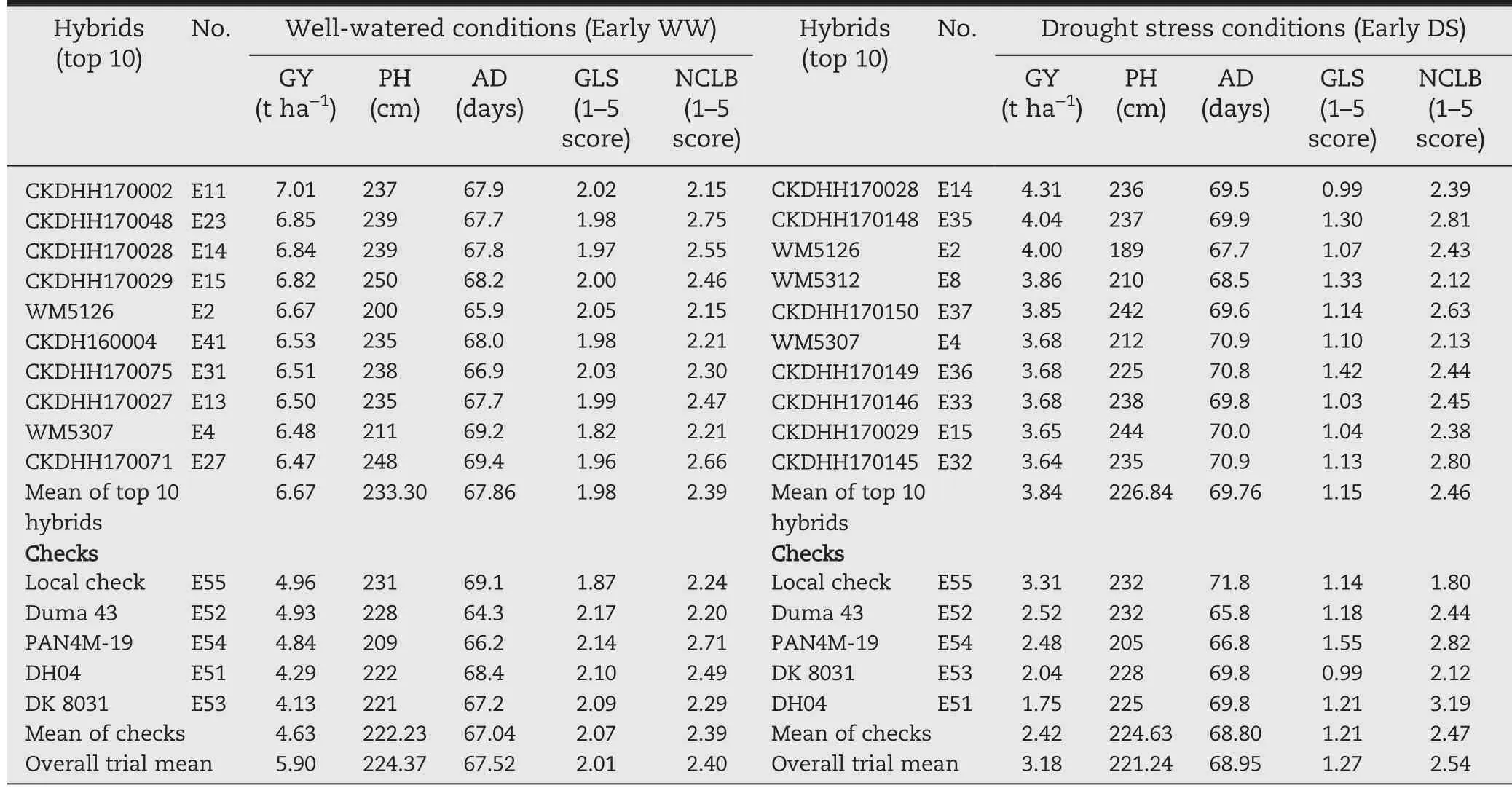
Table 3-Grain yield(GY),plant height(PH),days to anthesis(AD),gray leaf spot(GLS),and northern corn leaf blight(NCLB)trait values of the top 10 hybrids relative to commercial checks in early-maturity trials(Early WW and Early DS).
In the intermediate-maturing hybrids evaluated across 24 WW locations (hereafter referred to as Intermediate WW), the mean GY of the top 10 hybrids was 6.70 t ha-1,representing an increase of 0.7 t ha-1over the overall mean of the trial andchecks (Table 4). In combination across six DS locations(hereafter, Intermediate DS), the top 10 hybrids produced a mean of 3.51 t ha-1, which was 0.76 t ha-1higher than the overall mean and 0.93 t ha-1(36%) higher than the mean of checks. Among the intermediate-maturing hybrids, the top 10 hybrids produced 8.5%-13.5%higher yield than the commercial checks under WW conditions, while the top 10 hybrids under DS yielded 25.2%-47.7%more than the commercial checks.
3.2. Suitability of locations for selecting hybrids according to the GGE biplot method
Fig.1 shows the discriminativeness and representativeness of testing locations according to the GGE biplot method for the early- and intermediate-maturing hybrids evaluated under WW and DS locations(Early WW,Early DS,Intermediate WW,and Intermediate DS). The first two components in these biplots accounted for between 44.52% and 71.88% of total variation,depending on the trial.
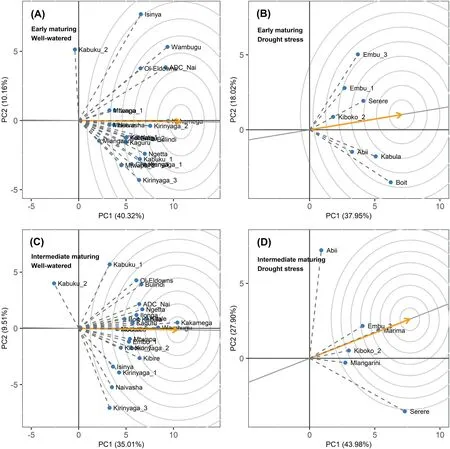
Fig.1-Discriminativeness and representativeness of test environments according to the GGE biplot method for maize trials in eastern Africa.(A)Early-maturity hybrids in well-watered conditions.(B) Early-maturity hybrids in drought stress conditions.(C)Intermediate-maturity hybrids in well-watered conditions.(D)Intermediate-maturity hybrids in drought stress conditions.
In the Early WW trial, Wambugu, Isinya, ADC Nai, and Kakamega locations show longer vectors than other locations,indicating that they were the most informative locations for genetic differentiation of the hybrids.The least discriminatory locations were Mlangarini,Mbeere,Naivasha,and Mtwapa,as they show short environment vectors(Fig.1A).Kakamega and Kirinyaga 2 were the most representative locations, as they show smaller angles with the Average-Environment Axis(AEA; Fig. 1A). Overall, Kakamega, Kirinyaga 2, and Bulindi were the ideal testing locations for evaluating hybrids,as they show long environmental vectors(informativeness)and small angle with AEA (representativeness). In contrast, Kabuku 2 was the least suitable environment for selecting hybrids,given that it shows a large angle with AEA (indicating less representativeness).
In the Early DS trials, Embu 3, Boit, and Kabula were the most informative locations,as they show long environmental vectors,and Serere and Kiboko 2 were the most representative as they show small angles with AEA (Fig. 1B). In this trial,Serere and Kabula were closest to the ideal location to assess the hybrids, as they show longer environmental vectors(indicating informativeness) and small angle with AEA(indicating representativeness). The suitability for selecting hybrids in the other locations was similar.
In the Intermediate WW trial, the most informative locations were Kakamega,Wambugu,Kirinyaga 3,Bulindi,and Ol-Eldowns, as they show long environmental vectors. The most representative locations were Wambugu,Kochalia,Mbeere,and Kakamega,as they show very small angles with AEA(Fig.1C).In this trial,Wambugu and Kakamega were the ideal locations for evaluating the hybrids for high yield potential under wellwatered conditions, because they show very high discriminatory ability (long environmental vectors) and representativeness(low angle with AEA).In contrast,Kabuku 2,Kabuku 1,and Kirinyaga 3 were the least suitable for selecting hybrids in this trial,as they show very low representativeness.
I lay there for the rest of that miserable15 voyage. When I finally tottered16(,) off the boat, I said I d never step off solid ground again. Dad said he felt the same way.
In the Intermediate DS trials, the most informative locations were Serere and Abii (Fig. 1D). In this trial, Marima was the best location for assessing the hybrids for tolerance to drought stress because it showed good discriminativeness and high representativeness. Abii and Serere were the least suitable for selecting hybrids because they showed very low representativeness.Considering all WW trials,Kakamega was the best location for selecting maize hybrids for yield owing to its both high discriminativeness and high representativeness in Early WW and Intermediate WW trials. In these trials,Kabuku 2 showed very low representativeness.
3.3. Stability of hybrids according to the GGE biplot method
Fig. 2 shows that high variation was found in mean GY and stability across environments.The GGE biplot shows that 60%of the early maturing hybrids displayed above-average performance across WW locations (Fig. 2A). Hybrids E23,E15, and E12 were closest to the ideal genotype in the Early WW trial (Fig. 2A). Although E11 was very high-yielding(7.01 t ha-1; Table 2), its behavior was very unstable (located far from 0 for principal component 2). Thus, it was far from the ideal genotype. Although E12 (with a yield of 6.39 t ha-1)was not ranked among the 10 highest-yielding hybrids(6.47-7.01 t ha-1),it had grain yield similar to those of the 10 highest-yielding hybrids and showed very high stability(close to 0 for principal component 2).All commercial checks(E51, E52, E53, E54, and E55) showed negative PC1 scores,implying that these hybrids had below-average performance across WW locations.
In the Early DS trial,E4,E37,and E2 were closest to the ideal genotype (Fig. 2B). These hybrids were also among the top 10 performing hybrids for grain yield under DS conditions(Table 2). Hybrids E51, E52, E53, and E54 (commercial checks) had negative PC1 scores, implying that these hybrids had belowaverage performance across DS locations.
In the Intermediate WW trial, the GGE biplot identified I8,I35, and I15 to be close to the ideal genotypes (Fig. 2C). The three hybrids were also among the top-performing hybrids across the 24 WW locations (Table 4). Two of the commercial checks (I62 and I65) had negative PC1 scores, suggesting below-average performance across the 24 WW locations. In the Intermediate DS trial, the closest hybrids to the ideal genotype were I41, I21, I7, I10, and I4 (Fig. 2D). All the five hybrids were also among the best-performing for GY across DS locations.Four of the commercial hybrids(I61,I62,I64 and I65)were below-average performers,as they had negative PC1 scores.
3.4. Stability of hybrids according to the Cruz et al. [24]method
According to the bi-segmented regression method,there were 12 favorable locations in early-maturity trials (I+; locations where the mean yield was higher than the overall mean yield), all of which were WW (data not shown). Also, there were 18 unfavorable locations (I-; locations where the mean yield was lower than the overall mean yield),of which 11 were WW and seven were in DS conditions.
In the early-maturity trials, the best hybrids were E2 and E14(Table 5).The hybrid E14 showed high mean yields in both unfavorable and favorable locations, good adaptability to unfavorable locations (β1= 1), excellent adaptability to favorable locations (β1+ β2>1), and high stability (= 0). Hybrid E2 showed a high mean yield in both unfavorable and favorable locations, good adaptability in both unfavorable(β1= 1)and favorable locations(β1+ β2= 1),and high stability(= 0).In contrast,hybrids E11 and E15 produced high mean yield but were unstable.
In the intermediate-maturity trials,there were 14 favorable locations,all of which were WW(data not shown).Also,there were 16 unfavorable locations, of which 10 were WW and six were DS. In these trials,the best genotypes were I21,I35, and I41, showing high mean yield in both unfavorable and favorable locations, good adaptability in both unfavorable(β1= 1)and favorable locations(β1+ β2= 1),and high stability(= 0).Hybrid I47,identified by the GGE biplot method as one of the best hybrids,showed good values of adaptability(β1= 1 and β1+ β2>1) and stability (= 0) according to the Cruz et al.method(data not shown),but its yield(5.73 t ha-1)was not very high. For this reason, it was not listed as one of the best by this method.
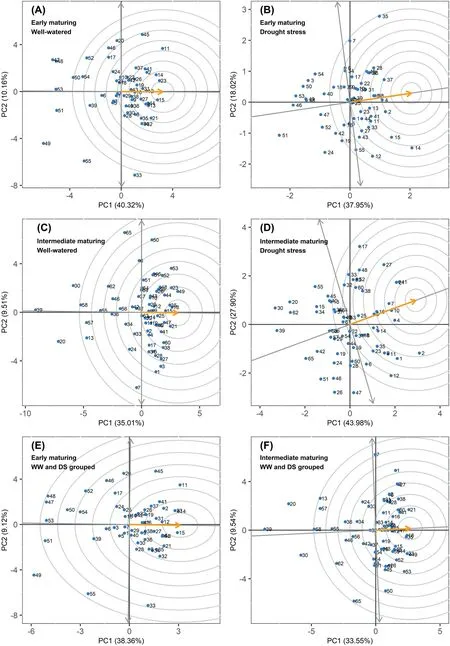
Fig.2-Ranking of hybrids relative to the ideal hybrid based on their mean and stability according to the GGE biplot method for maize trials in eastern Africa.(A)Early-maturity hybrids in well-watered(WW)conditions.(B) Early-maturity hybrids in drought stress(DS)conditions.(C)Intermediate-maturity hybrids in WW conditions. (D)Intermediate-maturity hybrids in DS conditions. (E) Early-maturity hybrids in all locations(WW and DS conditions). (F)Intermediate-maturity hybrids in all locations(WW and DS conditions).
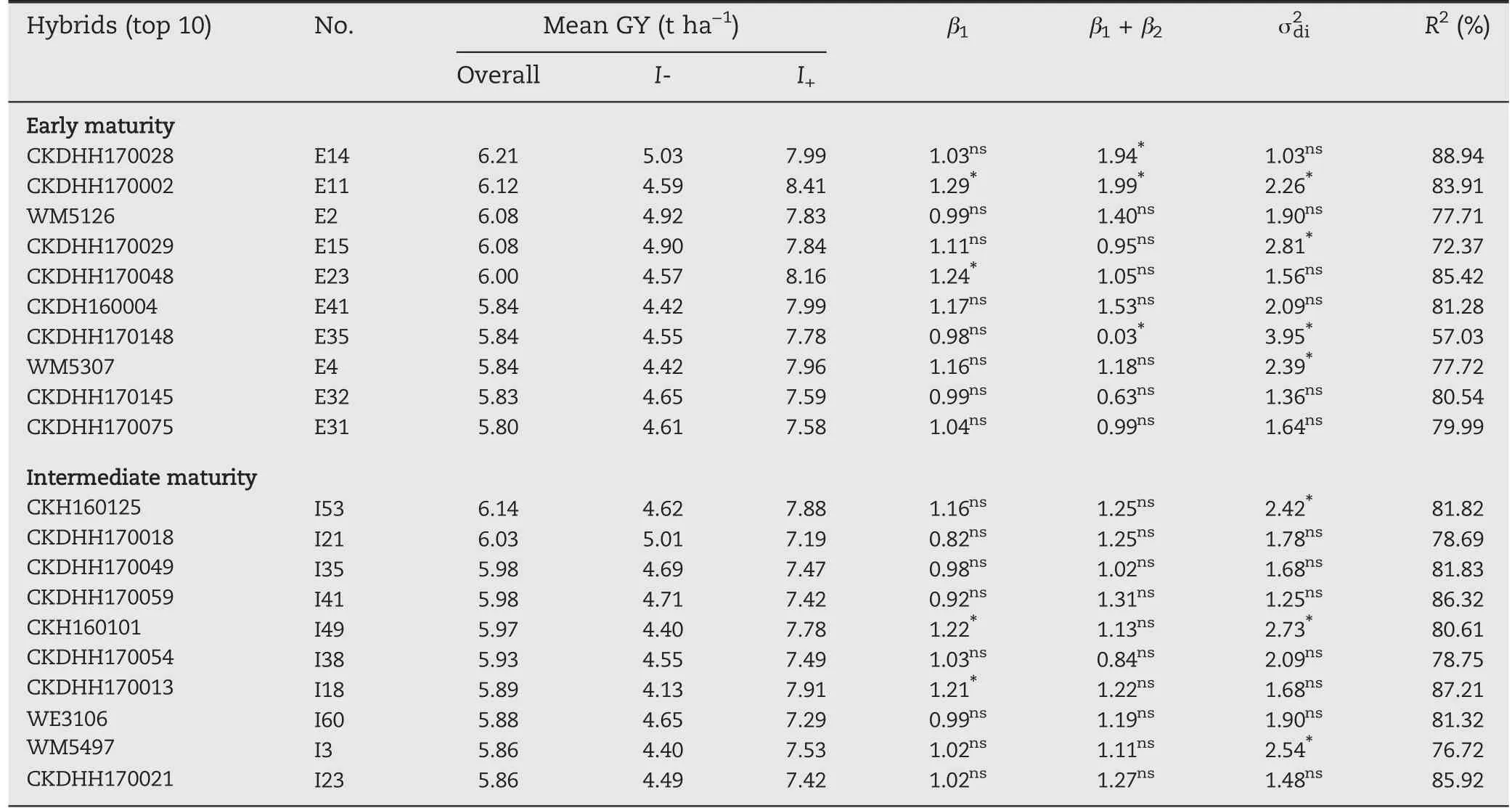
Table 5-Parameters of adaptability and stability,according to a bi-segmented regression method,of the 10 highest-ranking maize hybrids(top 10)in terms of yield in all early-maturity trials and in all intermediate-maturity trials.
4. Discussion
The means of the top 10 experimental hybrids across DS locations were respectively 3.84 and 3.51 t ha-1among early- and intermediate-maturing hybrid trials. Although most of the data were obtained from researcher-managed trials, these yields were high for eastern Africa, where the mean grain yield under farmer management conditions is only 1.75 t ha-1[2].In our study,DS reduced yield by 46%in early-maturing and by 54% in intermediate-maturing hybrids. These results are within the ranges of 58%-76%decrease previously reported in maize by Beyene et al. [38]and Cairns et al. [40], but much higher than the 11%decrease reported by Sserumaga et al. [39], under DS conditions.
The wide variation in grain yield decrease under drought stress could be attributed to varying levels of drought tolerance in the experimental hybrids, the crop growth stage at which drought stress occurred, and the severity and duration of the drought stress [10,11]. Edmeades et al. [41]reported that the phenotypic correlation between elite hybrid yields under drought stress versus under WW conditions declined when yield reductions reached 50%. They suggested that drought stress-adaptive mechanisms were not expressed until yields had been reduced by 30%-50% under stress compared to WW conditions. In our study, mean grain yields of early-maturing and intermediate-maturing trials under DS were reduced to 46%-56% of mean yields of hybrids under WW conditions, in the same range of yield reduction indicated by Edmeades et al. Thus, the top 10 hybrids identified in the present study may carry some adaptive traits for drought tolerance and some or all of their parental lines might be used in maize breeding programs in eastern Africa as sources of drought tolerance.
The mean GYs for early- and intermediate-maturing hybrids were similar under WW but different under DS conditions. The mean GY in the Intermediate DS trial was 2.57 t ha-1, lower than that in the Early DS trial (3.18 t ha-1)indicating that intermediate-maturity hybrids were more adversely affected by drought stress.
Heritabilities of GY in early- and intermediate-maturing hybrids were lower in DS than in WW conditions(Tables 2,3).These results are consistent with those reported from previous studies in maize [7,39]. The lower heritability of GY in our drought stress trials indicates that secondary traits(minimum anthesis-silking interval (ASI)) with higher heritability can improve selection response[42].
In a maize breeding program, most efforts are spent on evaluating inbred lines by crossing them to a tester and extensively evaluating them in replicated multi-location trials. It is, therefore, important to identify differences in discriminativeness and representativeness among test environments. In the WW trials, the best and worst locations for selecting the hybrids were similar between early-and intermediate-maturity hybrids. For WW locations, Kakamega was the best location and Kabuku the least suitable.However,considering all DS trials, the best locations were highly dependent on the hybrid maturity. For example, Serere was one of the best locations in the Early DS trial but one of the poorest in the Intermediate DS trial(Fig.1).Most of the highly informative locations(Embu 3 in Early DS and Abii and Serere in Intermediate DS) were also the least representative. This result demonstrates the difficulty in selecting the best locations for drought screening trials. Similar observations led CIMMYT to develop the concept of managed drought stress testing in SSA[43].
In this study, the GGE biplot clearly identified hybrids adapted to WW, to DS, and to both conditions. For example,hybrid E12 (early maturing), and hybrid I15 (intermediate maturing) were high-yielding and well-adapted in WW locations, while hybrid E37 (early maturing) and hybrid I7(intermediate maturing) were high-yielding and stable in DS locations.High mean yields and stability under DS conditions are important selection criterion for ensuring good harvests in eastern Africa[5,44,45].
Crop production in SSA is mostly rain-dependent, and grain production is vulnerable to the fluctuation of rainfall amount, distribution, and duration. It is accordingly important to develop hybrids that can withstand DS throughout the growing season but especially during flowering stage,but that suffer no yield penalty under optimum moisture conditions.Maize hybrids with these characteristics would contribute to greater food security and reduced risk to farming communities in drought-prone agro-ecologies of SSA. According to the GGE biplot, some hybrids with these characteristics were found in combined trial analyses(Fig.1E,F).They include the early-maturity hybrid E14 and the intermediate-maturity hybrid I35.
A bi-segmented regression method can be used for identifying suitable genotypes in studies with both WW and DS conditions. This method can identify hybrids that are stable and well-adapted simultaneously to WW and DS conditions. This ideal and stable genotype should have high β0(high mean yield),= 0, (high stability),β1<1 (adaptability to unfavorable environments) and β1+ β2>1 (adaptability to favorable environments) [24,29]. Genotypes close to the ideal genotype were found, and included, in early-maturity trials, E14, which showed high overall yield (6.21 t ha-1), high stability (= 0),high responsiveness in favorable conditions(β1+ β2>1), and medium responsiveness in unfavorable conditions (β1= 1). The bi-segmented regression method makes it more laborious than the GGE biplot method to identify the best genotypes owing to its large number of parameters, but allows for more details in the genotype analysis. For this reason, the Cruz et al. [24] method, unlike the GGE biplot, allowed the observation that the early maturing hybrid E2 is a good genotype for a wide range of environments. This is because it showed high yield, high stability, and responsive in both unfavorable and favorable conditions (β1and β1+ β2= 1). Although E2 was not classified by the GGE biplot as one of the best genotypes, it was reasonably close to the ideal genotype in the biplot(the center of the concentric circle in the plot in Fig.2E).
The genotypes E12 and I47 were well classified by the GGE biplot method into early and intermediate maturities,respectively, though they did not appear in the top 10 highestyielding hybrids and had not performed well in DS trials.They were classified by the GGE biplot in combined analyses because there were more WW locations than DS locations.For this reason, the WW locations had more influence on the choice. Although these genotypes were stable, they were not assigned to the best genotypes by the Cruz et al. method,owing to their low yields.
The use of complementary statistics to study the stability of genotypes can increase confidence in the selection process in plant breeding [30]. Silva et al. [46] reported a low correlation between a bi-segmented regression method and AMMI, a multivariate method that is like the GGE biplot method.However,a bi-segmented regression method and the GGE biplot offer different advantages.A bi-segmented regression method has adaptability parameters (β1and β1+ β2) to assess genotype responsiveness to environmental differences. The GGE biplot method considers only the relevant variation sources in the GE interaction study, namely genotype (G) and GE interaction, and assesses simultaneously the genotypes (mean and stability) and the test environments(discriminativeness and representativeness) [20]. For this reason,the GGE biplot and a bi-segmented regression method can be considered complementary methods. In the present study, using both methods it was possible to identify confidently the early-maturity hybrids E14 (CKDHH170028),E2 (WM5126), and E23 (CKDHH170048) and the intermediatematurity hybrids I35 (CKDHH170049), I18 (CKDHH170013), I21(CKDHH170018),and I41(CKDHH170059)as being well adapted to both WW and DS conditions.
5. Conclusions
We have identified the early-maturity hybrids E14(CKDHH170028), E2 (WM5126), and E23 (CKDHH170048) and the intermediate-maturity hybrids I35 (CKDHH170049), I18(CKDHH170013), I21 (CKDHH170018), and I41 (CKDHH170059)as being well adapted to both well-watered and drought stress conditions. They can be recommended for commercial production in diverse agro-ecologies of eastern Africa. We have also identified discriminative and representative testing locations that will facilitate allocating resources and streamlining the CIMMYT maize hybrid testing program in eastern Africa.
Acknowledgments
This research was supported by the Bill and Melinda Gates Foundation,the Howard G.Buffett Foundation,and the United States Agency for International Development(USAID)through the Water Efficient Maize for Africa(WEMA)project,the Stress Tolerant Maize for Africa (STMA) project, and the CGIAR Research Program MAIZE. The CGIAR Research Program MAIZE receives W1&W2 support from the Governments of Australia, Belgium, Canada, China, France, India, Japan, the Republic of Korea, Mexico, the Netherlands, New Zealand,Norway, Sweden, Switzerland, United Kingdom, the United States, and the World Bank. We thank International Maize and Wheat Improvement Center (CIMMYT) and Kenya Agricultural & Livestock Research Organization (KALRO) technicians for data collection at various experimental sites. We thank the Brazilian Council for Scientific and Technological Development (CNPq) and Brazilian Coordination for the Improvement of Higher Education Personnel (CAPES) for a scholarship supporting Wender Rezende. We also thank Paul Ravensbergen for valuable revisions and suggestions in previous versions of this paper.
- The Crop Journal的其它文章
- Brief Guide for Authors
- Rapid generation advance(RGA)in chickpea to produce up to seven generations per year and enable speed breeding
- Transcriptomic responses in resistant and susceptible maize infected with Fusarium graminearum
- Relay-intercropping soybean with maize maintains soil fertility and increases nitrogen recovery efficiency by reducing nitrogen input
- Genetic analysis and QTL mapping of stalk cell wall components and digestibility in maize recombinant inbred lines from B73 × By804
- Genetic bases of source-, sink-, and yield-related traits revealed by genome-wide association study in Xian rice

